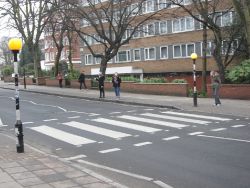Pedestrian Crossing
| Pedestrian Crossing | ||
 | ||
| The famous zebra crossing on Abbey Road in north London | ||
| Pictures related to Pedestrian Crossing View gallery (55) | ||
| Quick Links | ||
| Tiger Crossing • Toucan Crossing • Puffin Crossing • Pelican Crossing • Pegasus Crossing • Zebra Crossing | ||
| Related Terms | ||
| Belisha Beacon | ||
Pedestrian Crossings are designed to be safe locations for pedestrians to cross roads, and are generally found in urban areas. Whilst technically many sets of Traffic lights include pedestrian phases, these are not generally thought of as being a form of Pedestrian Crossing. They are often used in conjunction with pedestrian barriers.
The first recognisably modern Pedestrian Crossings in the UK were created in Manchester in 1929 by Forest City Ltd., and spread to many areas across the 1930s; though they were not generally popular with the Highway Authorities of the time. These light-controlled crossings were created less than two years after the first experimental automatic traffic lights were installed in Princes Square, Wolverhampton in November 1927.
Later, these were replaced by uncontrolled crossings of the Zebra Crossing, whilst a number of false starts for controlled crossings finally ended up in the familiar Pelican Crossings and their descendants.
Most UK Pedestrian crossings since the Zebra have have been named after animals.
Zebra
| Pictures related to Zebra Crossing View gallery (87) |
A Zebra Crossing is a type of unsignalised pedestrian crossing, marked by a series of black-and-white stripes painted on the road surface parallel to the kerb, a line of studs perpendicular to the kerb, and the famous orange Belisha beacons. All road traffic must give way to pedestrians wishing to cross at the points so marked. Zebra crossings are the most common type of pedestrian crossing across cycle tracks, although Belisha beacons can be omitted when used only at a cycle track.
Pelican
| Pictures related to Pelican Crossing View gallery (108) |
A Pelican Crossing is a type of pedestrian crossing controlled by traffic signals, introduced in 1969. Pedestrians cross the road by pressing a button located at the side of the road, which after a period of time shows traffic on the road a red signal, allowing pedestrians to cross. They are considered to be obsolete although a few do remain, but usually replaced with a Puffin crossing when renewed.
"Pelican" is an abbreviation of PEdestrian LIght CONtrolled crossing, with adjusted spelling.
Puffin
| Pictures related to Puffin Crossing View gallery (58) |
A Puffin Crossing is a type of pedestrian crossing, similar to a Pelican Crossing, controlled by traffic signals. They are most obviously differentiated by the pedestrian signals being located on the same side of the road as a pedestrian, rather than the opposite side as per a Pelican.
This location is cited to be so that pedestrians have oncoming traffic within their field of vision, but they are relatively unpopular with sections of the public when compared to the earlier Pelican. They are named on the seabird theme.
Toucan
| Pictures related to Toucan Crossing View gallery (25) |
A Toucan Crossing is a type of controlled crossing that is designed for use by both pedestrians and cyclists, and so have a specific symbol for cyclists. They are descendants of the Pelican; and whilst the name is of a similar format to others in terms of being a type of bird, it is actually a clever pun on the fact that "Two Can Cross".
Pegasus
| Pictures related to Pegasus Crossing View gallery (9) |
Pegasus Crossings are another descendant of the Pelican, but designed for horse riders. As such, extra push buttons are made available at an increased height for horse riders; with red and green horse pictograms.
They are often combined with crossings for pedestrians, with a second push button unit at the standard height. They are named after the mythical flying horse.
Tiger
| Pictures related to Tiger Crossing View gallery (3) |
A Tiger Crossing (or Parallel Crossing) is an uncontrolled crossing that can best be thought of as a cross between a Zebra crossing and a Toucan crossing, in that is a a descendant of the Zebra crossing that is designed for use by both pedestrians and cyclists, however segregated.
Panda
Panda Crossings were a short-lived type of controlled crossing, which featured triangular markings on the road surface. They were a confusing mix of flashing and pulsating lights for the vehicular user; and so were replaced quickly.
X-way
X-way Crossings (pronounces as crossway) were another experimental type of controlled crossing, best thought of as a prototype Pelican. They featured white "X" lights instead of green for vehicles with the idea being that it differentiated crossings from junctions.
Forest City
The Forest City Crossing was the earliest type of controlled crossing in the UK, and are recognisably similar to modern crossings.
Green Person Authority
Green Person Authority is a setup at a pedestrian crossing that defaults to giving pedestrians a green man and vehicular traffic a red light. Once a vehicle is detected on approach, the lights change to allow vehicles through. These started to be rolled out in London in 2021, although there may have been earlier cases. These have a benefit over zebra crossings as it dedicates vehicular traffic green light while a zebra crossing may continuous crossed by a stream of pedestrians.










